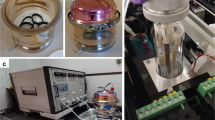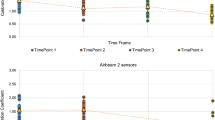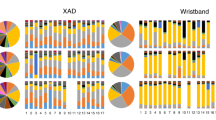Abstract
Background
Organic contaminants are released into the air from building materials/furnishings, personal care, and household products. Wearable passive samplers have emerged as tools to characterize personal chemical exposures. The optimal placement of these samplers on an individual to best capture airborne exposures has yet to be evaluated.
Objective
To compare personal exposure to airborne contaminants detected using wearable passive air samplers placed at different positions on the body.
Methods
Participants (n = 32) simultaneously wore four passive Fresh Air samplers, on their head, chest, wrist, and foot for 24 hours. Exposure to 56 airborne organic contaminants was evaluated using thermal desorption gas chromatography high resolution mass spectrometry with a targeted data analysis approach.
Results
Distinct exposure patterns were detected by samplers positioned on different parts of the body. Chest and wrist samplers were the most similar with correlations identified for 20% of chemical exposures (Spearman’s Rho > 0.8, p < 0.05). In contrast, the greatest differences were found for head and foot samplers with the weakest correlations across evaluated exposures (8% compounds, Spearman’s Rho > 0.8, p < 0.05).
Significance
The placement of wearable passive air samplers influences the exposures captured and should be considered in future exposure and epidemiological studies.
Impact statement
Traditional approaches for assessing personal exposure to airborne contaminants with active samplers presents challenges due to their cost, size, and weight.
Wearable passive samplers have recently emerged as a non-invasive, lower cost tool for measuring environmental exposures. While these samplers can be worn on different parts of the body, their position can influence the type of exposure that is captured. This study comprehensively evaluates the exposure to airborne chemical contaminants measured at different passive sampler positions worn on the head, chest, wrist, and foot. Findings provide guidance on sampler placement based on chemicals and emission sources of interest.

This is a preview of subscription content, access via your institution
Access options
Subscribe to this journal
Receive 6 print issues and online access
$259.00 per year
only $43.17 per issue
Buy this article
- Purchase on Springer Link
- Instant access to full article PDF
Prices may be subject to local taxes which are calculated during checkout




Similar content being viewed by others
Data availability
The dataset generated during and analysed during the current study are available from the corresponding author on reasonable request.
References
Choi H, Perera F, Pac A, Wang L, Flak E, Mroz E, et al. Estimating Individual-Level Exposure to Airborne Polycyclic Aromatic Hydrocarbons throughout the Gestational Period Based on Personal, Indoor, and Outdoor Monitoring. Environ Health Perspect. 2008;116:1509–18.
Koniecki D, Wang R, Moody RP, Zhu J. Phthalates in cosmetic and personal care products: Concentrations and possible dermal exposure. Environ Res. 2011;111:329–36.
Li A, Schoonover TM, Zou Q, Norlock F, Conroy LM, Scheff PA, et al. Polycyclic aromatic hydrocarbons in residential air of ten Chicago area homes: Concentrations and influencing factors. Atmos Environ. 2005;39:3491–501.
Phillips AL, Hammel SC, Hoffman K, Lorenzo AM, Chen A, Webster TF, et al. Children’s residential exposure to organophosphate ester flame retardants and plasticizers: Investigating exposure pathways in the TESIE study. Environ Int. 2018;116:176–85.
Wang S, Romanak KA, Stubbings WA, Arrandale VH, Hendryx M, Diamond ML, et al. Silicone wristbands integrate dermal and inhalation exposures to semi-volatile organic compounds (SVOCs). Environ Int. 2019;132:105104.
Choi H, Zdeb M, Perera F, Spengler J. Estimation of chronic personal exposure to airborne polycyclic aromatic hydrocarbons. Sci Total Environ. 2015;527-528:252–61.
Choi H, Spengler J. Source attribution of personal exposure to airborne polycyclic aromatic hydrocarbon mixture using concurrent personal, indoor, and outdoor measurements. Environ Int. 2014;63:173–81.
Weschler CJ, Nazaroff WW. Semivolatile organic compounds in indoor environments. Atmos Environ. 2008;42:9018–40.
Doherty BT, Koelmel JP, Lin EZ, Romano ME, Godri Pollitt KJ. Use of Exposomic Methods Incorporating Sensors in Environmental Epidemiology. Current Environmental. Health Rep. 2021;8:34–41.
Calafat AM, Needham LL. What additional factors beyond state-of-the-art analytical methods are needed for optimal generation and interpretation of biomonitoring data? Environ Health Perspect. 2009;117:1481–5.
Dixon HM, Scott RP, Holmes D, Calero L, Kincl LD, Waters KM, et al. Silicone wristbands compared with traditional polycyclic aromatic hydrocarbon exposure assessment methods. Anal Bioanal Chem. 2018;410:3059–71.
Zabiegała B, Kot-Wasik A, Urbanowicz M, Namieśnik J. Passive sampling as a tool for obtaining reliable analytical information in environmental quality monitoring. Anal Bioanal Chem. 2010;396:273–96.
Bartkow ME, Hawker DW, Kennedy KE, Müller JF. Characterizing Uptake Kinetics of PAHs from the Air Using Polyethylene-Based Passive Air Samplers of Multiple Surface Area-to-Volume Ratios. Environ Sci Technol. 2004;38:2701–6.
Desmet K, De Coensel N, Górecki T, Sandra P. Profiling the spatial concentration of allethrin and piperonyl butoxide using passive sorptive sampling and thermal desorption capillary GC–MS. Chemosphere. 2008;71:2193–8.
Jo S-H, Kim K-H, Kwon K. The combined effects of sampling parameters on the sorbent tube sampling of phthalates in air. Sci Rep. 2017;7:45677.
Kenessov B, Sailaukhanuly Y, Koziel JA, Carlsen L. Nauryzbayev M GC–MS and GC–NPD Determination of Formaldehyde Dimethylhydrazone in Water Using SPME. Chromatographia. 2011;73:123–8.
Magnusson R, Arnoldsson K, Lejon C, Hägglund L, Wingfors H. Field evaluation and calibration of a small axial passive air sampler for gaseous and particle bound polycyclic aromatic hydrocarbons (PAHs) and oxygenated PAHs. Environ Pollut. 2016;216:235–44.
Okeme JO, Yang C, Abdollahi A, Dhal S, Harris SA, Jantunen LM, et al. Passive air sampling of flame retardants and plasticizers in Canadian homes using PDMS, XAD-coated PDMS and PUF samplers. Environ Pollut. 2018;239:109–17.
Paschke H, Popp P. New passive samplers for chlorinated semivolatile organic pollutants in ambient air. Chemosphere. 2005;58:855–63.
Paulik LB, Hobbie KA, Rohlman D, Smith BW, Scott RP, Kincl L, et al. Environmental and individual PAH exposures near rural natural gas extraction. Environ Pollut. 2018;241:397–405.
Schäfer RB, Hearn L, Kefford BJ, Mueller JF, Nugegoda D. Using silicone passive samplers to detect polycyclic aromatic hydrocarbons from wildfires in streams and potential acute effects for invertebrate communities. Water Res. 2010;44:4590–600.
Gaga EO, Harner T, Dabek-Zlotorzynska E, Celo V, Evans G, Jeong C-H, et al. Polyurethane Foam (PUF) Disk Samplers for Measuring Trace Metals in Ambient Air. Environ Sci Technol Lett. 2019;6:545–50.
Lin EZ, Esenther S, Mascelloni M, Irfan F, Godri Pollitt KJ. The Fresh Air Wristband: A Wearable Air Pollutant Sampler. Environ Sci Technol Lett. 2020;7:308–14.
Okeme JO, Nguyen LV, Lorenzo M, Dhal S, Pico Y, Arrandale VH, et al. Polydimethylsiloxane (silicone rubber) brooch as a personal passive air sampler for semi-volatile organic compounds. Chemosphere. 2018;208:1002–7.
Hammel SC, Phillips AL, Hoffman K, Stapleton HM. Evaluating the Use of Silicone Wristbands To Measure Personal Exposure to Brominated Flame Retardants. Environ Sci Technol. 2018;52:11875–85.
Koelmel JP, Lin EZ, Nichols A, Guo P, Zhou Y, Godri Pollitt KJ. Head, Shoulders, Knees, and Toes: Placement of Wearable Passive Samplers Alters Exposure Profiles Observed. Environ Sci Technol. 2021;55:3796–806.
Patterson RE, Kirpich AS, Koelmel JP, Kalavalapalli S, Morse AM, Cusi K, et al. Improved experimental data processing for UHPLC–HRMS/MS lipidomics applied to nonalcoholic fatty liver disease. Metabolomics 2017;13:142.
Guo Y, Kannan KA. Survey of Phthalates and Parabens in Personal Care Products from the United States and Its Implications for Human Exposure. Environ Sci Technol. 2013;47:14442–9.
Weschler CJ, Salthammer T, Fromme H. Partitioning of phthalates among the gas phase, airborne particles and settled dust in indoor environments. Atmos Environ. 2008;42:1449–60.
Agency for Toxic Substances and Disease Registry. Toxicological Profile for Di-n-octyl Phthalate. U.S. Department of Health and Human Services, Public Health Service, Agency for Toxic Substances and Disease Registry: Atlanta, Georgia, USA; 1997.
Tran TM, Kannan K. Occurrence of phthalate diesters in particulate and vapor phases in indoor air and implications for human exposure in Albany, New York, USA. Arch Environ Contam Toxicol. 2015;68:489–99.
Duan X, Wang B, Zhao X, Shen G, Xia Z, Huang N, et al. Personal inhalation exposure to polycyclic aromatic hydrocarbons in urban and rural residents in a typical northern city in China. Indoor Air. 2014;24:464–73.
Du W, Li X, Chen Y, Shen G. Household air pollution and personal exposure to air pollutants in rural China - A review. Environ Pollut. 2018;237:625–38.
Svecova V, Topinka J, Solansky I, Rossner P Jr., Sram RJ. Personal exposure to carcinogenic polycyclic aromatic hydrocarbons in the Czech Republic. J Expo Sci Environ Epidemiol. 2013;23:350–5.
Liu Y, Tao S, Yang Y, Dou H, Yang Y, Coveney RM. Inhalation exposure of traffic police officers to polycyclic aromatic hydrocarbons (PAHs) during the winter in Beijing, China. Sci Total Environ. 2007;383:98–105.
Manzano CA, Dodder NG, Hoh E, Morales R. Patterns of Personal Exposure to Urban Pollutants Using Personal Passive Samplers and GC x GC/ToF-MS. Environ Sci Technol. 2019;53:614–24.
Dixon HM, Armstrong G, Barton M, Bergmann AJ, Bondy M, Halbleib ML, et al. Discovery of common chemical exposures across three continents using silicone wristbands. Royal Society Open. Science. 2019;6:181836.
Kameda T. Atmospheric Chemistry of Polycyclic Aromatic Hydrocarbons and Related Compounds. J Health Sci. 2011;57:504–11.
Kuo C-Y, Chien P-S, Kuo W-C, Wei C-T, Rau J-Y. Comparison of polycyclic aromatic hydrocarbon emissions on gasoline- and diesel-dominated routes. Environ Monit Assess. 2013;185:5749–61.
Yadav IC, Devi NL, Zhong G, Li J, Zhang G, Covaci A. Occurrence and fate of organophosphate ester flame retardants and plasticizers in indoor air and dust of Nepal: Implication for human exposure. Environ Pollut. 2017;229:668–78.
Whitehead TP, Metayer C, Park JS, Does M, Buffler PA, Rappaport SM. Levels of nicotine in dust from homes of smokeless tobacco users. Nicotine Tob Res. 2013;15:2045–52.
Hoh E, Hunt RN, Quintana PJ, Zakarian JM, Chatfield DA, Wittry BC, et al. Environmental tobacco smoke as a source of polycyclic aromatic hydrocarbons in settled household dust. Environ Sci Technol. 2012;46:4174–83.
Clawson AH, Ruppe NM, Nwankwo CN, Blair AL Profiles of Nicotine and Cannabis Exposure among Young Adults with Asthma. Behav Med. 2020;1–13. https://doi.org/10.1080/08964289.2020.1763904.
Brandhorst TT, Klein BS. Uncertainty surrounding the mechanism and safety of the post-harvest fungicide fludioxonil. Food Chem Toxicol. 2019;123:561–5.
Li C, Fu J, Sheng G, Bi X, Hao Y, Wang X, et al. Vertical distribution of PAHs in the indoor and outdoor PM2.5 in Guangzhou, China. Build Environ. 2005;40:329–41.
Langer S, Bekö G. Indoor air quality in the Swedish housing stock and its dependence on building characteristics. Build Environ. 2013;69:44–54.
Angel DM, Gao D, DeLay K, Lin EZ, Eldred J, Arnold W, et al. Development and Application of a Polydimethylsiloxane-Based Passive Air Sampler to Assess Personal Exposure to SARS-CoV-2. Environ Sci Technol Lett. 2022;9:153–9.
Acknowledgements
The authors would like to thank participants for taking part in the study. Funding for this work was received from the Yale School of Public Health.
Author information
Authors and Affiliations
Contributions
EZL designed the study, deployed and collected samples, prepared and analyzed samples, conducted statistical analysis, drafted and revised the manuscript. AN and YZ deployed and collected samples. JPK provided feedback during data analysis and revised the manuscript. KJGP conceived and designed the study, provided feedback throughout sample collection, sample and data analysis, and drafted and revised the manuscript.
Corresponding author
Ethics declarations
Competing interests
The authors declare no competing interests.
Additional information
Publisher’s note Springer Nature remains neutral with regard to jurisdictional claims in published maps and institutional affiliations.
Supplementary Information
Rights and permissions
About this article
Cite this article
Lin, E.Z., Nichols, A., Zhou, Y. et al. Characterizing the external exposome using passive samplers—comparative assessment of chemical exposures using different wearable form factors. J Expo Sci Environ Epidemiol 33, 558–565 (2023). https://doi.org/10.1038/s41370-022-00456-3
Received:
Revised:
Accepted:
Published:
Issue Date:
DOI: https://doi.org/10.1038/s41370-022-00456-3
Keywords
This article is cited by
-
Wearable Passive Samplers for Assessing Environmental Exposure to Organic Chemicals: Current Approaches and Future Directions
Current Environmental Health Reports (2023)



